
Preface

“Any fool can write a book but it takes a man to make a dovetail door.”
CHARLES FLETCHER LUMMIS
On a beautiful Southern California evening a couple of years ago, I had one of the more surreal experiences of my life. At about sunset, I found myself standing at the front door of the Gamble house, the best-known of a series of significant and wonderful residences designed by Charles and Henry Greene in the first decade of the 20th century. Having rung the doorbell, I waited for someone to answer, to open the door to the most beautiful man-made place I had ever been.
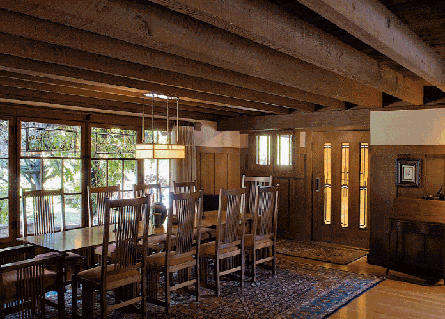
Greene & Greene achieved a rustic elegance even when working with modest materials. Dining room, Josephine van Rossem house, No. 1, Pasadena, 1903 (altered 1906).
My first visit to the Gamble house was in September 2000. I had pored over photographs of that house and others, but located in the Midwest, I had only daydreamed of experiencing the beauty firsthand. The visit was a revelation — even with my very tired six-month-old son in tow. While the exterior of the house is a work of art, inside one experiences sensory overload. Incredible views in every direction make it difficult to focus on any one object or detail for long. Normally patient, I suddenly had the attention span of a gnat. The one-hour tour passed far too quickly.
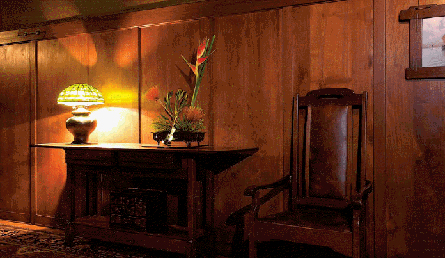
Wood glows and shadows entice in the twilight. Detail, entry hall, David B. Gamble house, Pasadena, 1907-09.
In subsequent years, I became increasingly enamored of the work of Greene & Greene. Their style began to dominate my woodworking designs and implementations. I continued to pore over books and magazine articles, and I continued to daydream, this time of a second visit to Pasadena, the center of the Greene & Greene universe.
It wasn’t until October 2007 that I had the opportunity to return. By that time, I was beginning work on a series of articles about Greene & Greene designs for Popular Woodworking Magazine. A chance meeting with Kori Capaldi, Operations Manager at the Gamble house, led to an invitation to a reception at the house for a speaker in the Sidney D. Gamble lecture series. Which brings us back to the remarkable art glass paneled front door on that remarkable Southern California evening.
The Gamble house is a magical place at night. Perhaps only a poet could describe the glow that seems to emanate from every wooden surface in the dim light provided by the fixtures designed by Greene & Greene. It is truly extraordinary. The combination of this unusual light and the shadowy darkness present in corners and recesses, gives the 8,000-square-foot house a comforting, homey quality that is both unexpected and immediate. Beyond any of my Midwestern daydreams, those couple of hours amplified my already considerable respect for the artistry of Charles and Henry Greene.
In Inventing the Dream: California Through the Progressive Era, Kevin Starr refers to Greene & Greene, writing that their “…Pasadena homes were poems of wood and light.” When reading that, I immediately recalled the wonderful light in the house at night and knew that I had found the title for this book. Since that evening, I have had the good fortune to visit numerous Greene & Greene houses. Each one, whether modest or masterpiece, is a wonder. In fact, each time I enter one, I am acutely aware of the privilege being granted me, of the opportunity to witness history and further understand the talented men who designed and built this incredible body of work.
At about the time that I began writing this book, my wife and I took a brief vacation to the Lodge at Torrey Pines in La Jolla, California. Perched on a prime piece of real estate overlooking the famed Torrey Pines golf courses and the Pacific Ocean, the lodge is likely the most substantial Greene & Greene-inspired structure ever built. While some purists might complain about compromises, one must bear in mind that this is not a private residence but a modern hotel that must meet strict building codes and accommodate guests in addition to presenting a beautiful reference to historic architecture.
While at the lodge, I met with Bill Evans, President of Evans Hotels, the lodge’s owner. The Lodge at Torrey Pines exists solely because of Bill Evans. It is a testament to his passion, energy and desire to create something exceptional. One of the first things Bill said to me was, “Does the world really need another Greene & Greene book?” He was joking. Mostly. I think. But it’s a valid question that deserves an answer.
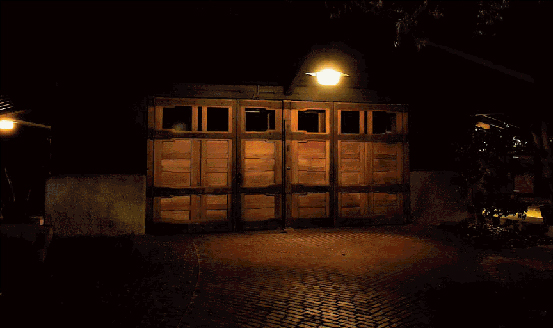
The garage didn’t receive the same attention as the house, but it certainly wasn’t an afterthought. Like all things, it can, and should, be made beautiful. Thus, the garage is unified in design with the house.
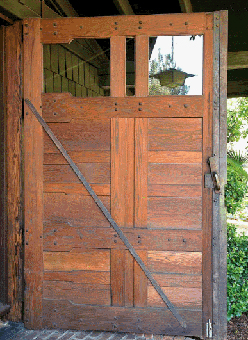
The door is functional but exhibits typical Greene & Greene elements. Garage, David B. Gamble house, Pasadena, 1907-09.
In the past couple of decades a number of books about Charles and Henry Greene, and their work, have appeared. Among them are volumes by those responsible for the Greene & Greene renaissance and the continued resurgence of their legacy. Anyone with an interest in this topic owes a debt of gratitude to Randell Makinson for helping to rescue their legacy and bring the Greenes’ work back from the brink of obscurity. Randell has authored several volumes including The Passion and the Legacy.
Randell discovered Greene & Greene while an architecture student at USC. One day he went to see the Gamble house (when Gambles still lived there). As Randell stood outside the house admiring the design, the front door opened, and a man demanded to know what Randell was doing. That man was Cecil Gamble, son of David and Mary Gamble who built the house. After an impromptu tour, Randell was hooked. He went on to help engineer the transfer of the house from the Gamble family to USC and the city of Pasadena and to be the house’s director for a couple of decades.
Current director of the Gamble House, Edward (Ted) Bosley has an equally compelling story. As an undergraduate at the University of California at Berkeley, Ted one day saw a house that intrigued him. It was the home of the local chapter of the Sigma Phi fraternity. It is also known as the Thorsen House, the last of the Greenes’ “Ultimate Bungalows.” Built in 1910 for lumber baron William Thorsen, the house and its furnishings are among the Greenes’ greatest accomplishments. Remarkably, those accomplishments are still visible even though it has been a fraternity house for more than 60 years.
Ted pledged Sigma Phi and lived in the house for four years. That he went on to become director of the Gamble House is one of those great American stories, like the kid who meets Babe Ruth and then grows up to play for the Yankees. Greene & Greene is Ted’s history of the brothers and their work. It is the definitive volume on the topic and a stunning achievement.
There are, of course, other excellent books on the subject of the Greenes and/or their commissions. Greene & Greene: Masterworks by Bruce Smith and Alexander Vertikoff is, in my opinion, the most notable. Bruce’s Greene & Greene scholarship is among the very best. His upcoming book on the Duncan-Irwin house is highly anticipated. Alexander Vertikoff is an outstanding architectural photographer, well known in the Arts & Crafts world. He is my photographic hero. His photos in Masterworks are beautiful.
This brings us back to the question that Bill Evans asked me, “Does the world really need another Greene & Greene book?” The unspoken subtext of that question goes something like this: “There are already many excellent books on the topic. Do you have anything new to add?” I believe that the answer to that question is “yes.” I submit that there is something new in these pages.
I have not tried to reinvent the wheel by writing a definitive history. Any such attempt would be doomed to failure by comparison. Makinson, Bosley and Smith have set a very high bar. Unlike the others, I came to Greene & Greene through woodworking. I was drawn to their spectacular designs: spare and graceful, with subtle details that define many pieces and, more generally, their style. Woodworkers, even hobbyists like me, develop an eye for details and a curiosity about how those details are implemented. It’s a blessing and a curse (go to a furniture store with a woodworker and you’ll see what I mean).
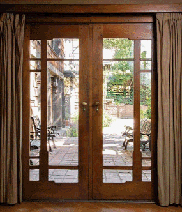
Greene & Greene took great care with seemingly minor details, such as doors. Patio doors, William R. Thorsen house, Berkeley, 1908-10.
Think of this book as a guided tour through the Greene & Greene store. There are many photos here of exteriors or entire rooms. What makes this book different, however, is that there are also many photos that focus on details. While the best books on the topic are filled with photos of pieces of furniture, the reader is often left wanting to see more, to see close-ups of inlays, pegs and joinery, the beautiful details that help define what we know as the Greene & Greene vocabulary. In these pages the reader will find those close-up shots along with discussion of the broader themes of the designs.
The topic of this book then is Greene & Greene design with a focus on the details that distinguish their work. Pegs and lifts are obvious and often used by designers to make a piece “Greene-ish.” Of course, there is much more variety, and subtlety, in the Greene canon. We explore that here. Additionally, it is best to examine Greene & Greene pieces in context. Every piece of furniture was designed to occupy a particular place in a particular house. Though much of the furniture no longer resides in the houses for which it was designed, we can consider the recurring, unifying themes that are an important aspect of the design philosophy, one that merits closer examination.
Only you can judge if this work has, in fact, contributed anything new to your enjoyment of and appreciation for the incredible output of Charles and Henry Greene. I sincerely hope that to be the case.
DAVID MATHIAS
December 2009